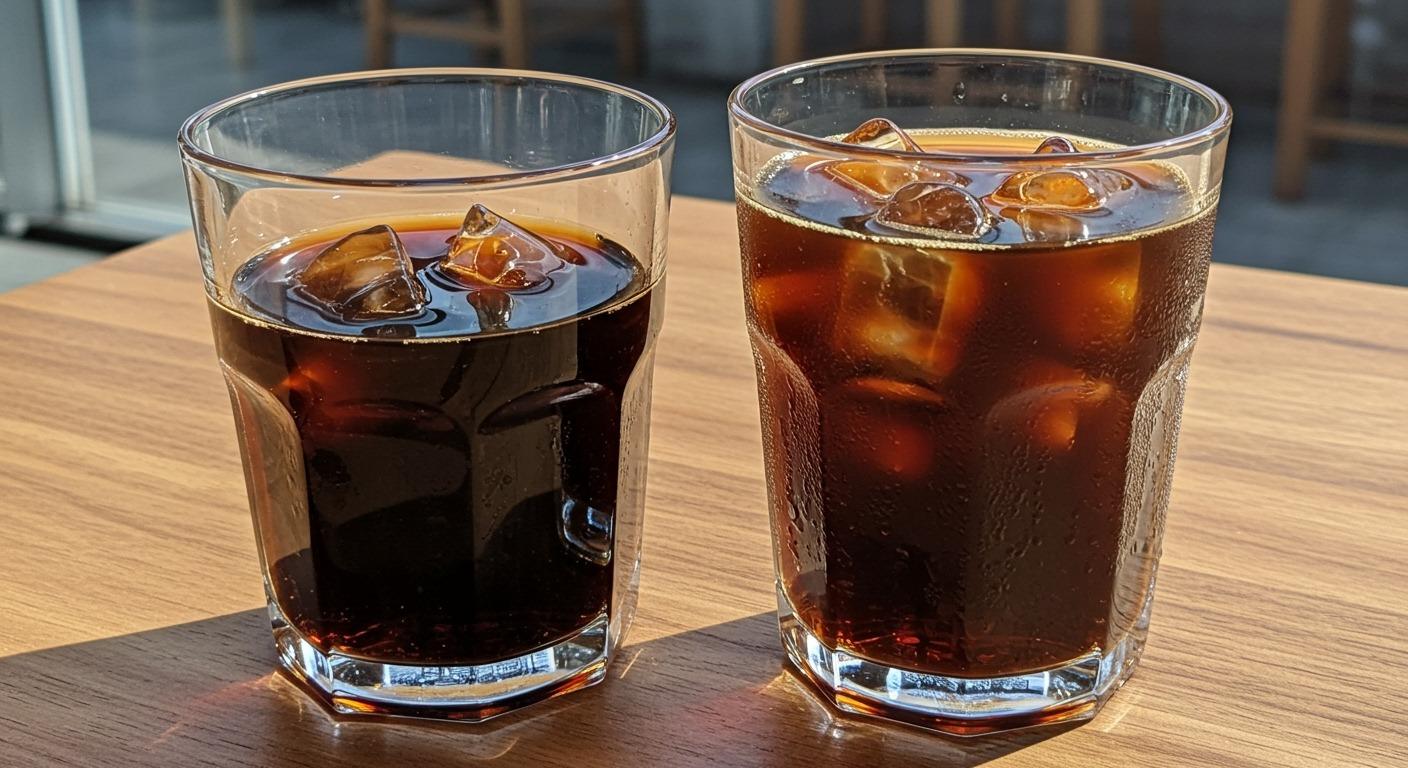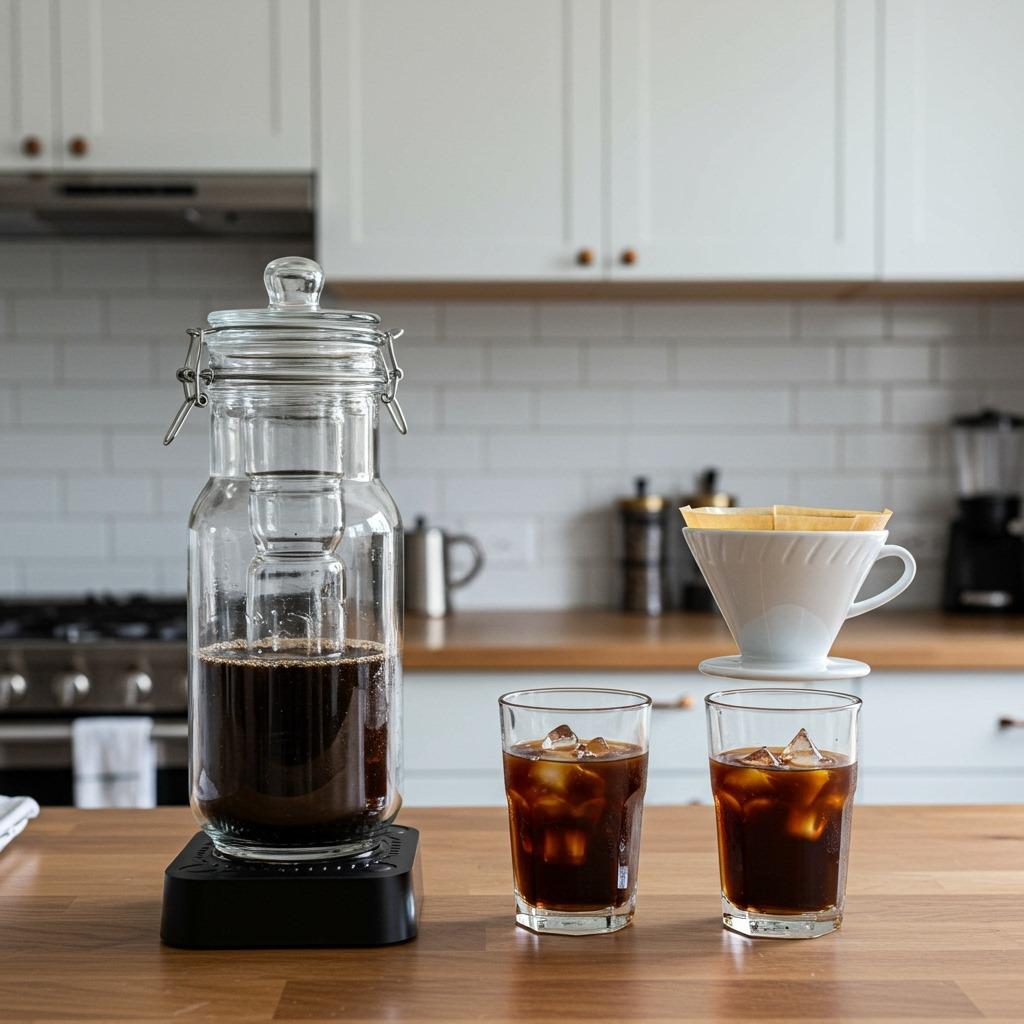Three weeks ago, I was sitting at my favorite local coffee shop when I overheard two customers arguing about their orders. One insisted their cold brew was wrong because it “tasted different from iced coffee,” while the other claimed they were basically the same thing. The barista looked exhausted, trying to explain the difference for what was probably the hundredth time that month.
That moment made me realize how confusing these two popular chilled coffee drinks can be for coffee lovers. While both deliver that refreshing caffeine kick we crave on hot days, cold brew and iced coffee are actually quite different in how they’re made, how they taste, and even how much caffeine they pack. Understanding these differences can completely change your coffee game and help you order exactly what you’re craving.

The Fundamental Brewing Difference
The biggest distinction between cold brew and iced coffee lies in their brewing methods, and this single difference creates a cascade of other variations in taste, strength, and texture.
Cold brew takes the patient approach. Coarsely ground coffee steeps in cold or room-temperature water for 12 to 24 hours, creating a smooth concentrate that’s later diluted with water, milk, or served over ice. This extended extraction process happens without any heat, allowing the coffee’s natural oils and flavors to slowly infuse into the water.
Iced coffee, on the other hand, follows the traditional hot brewing route. Coffee grounds are brewed with hot water using familiar methods like drip coffee makers, pour-over, or French press. The hot coffee is then cooled down and poured over ice. Some coffee shops brew their iced coffee directly over ice to speed up the cooling process and maintain flavor intensity.
This brewing difference affects everything else about these drinks, from their chemical composition to their final taste profile. The Specialty Coffee Association notes that water temperature during extraction significantly impacts which compounds are pulled from the coffee grounds, creating distinctly different beverages from the same beans.
Taste Profile: Smooth vs. Bright
The flavor differences between cold brew and iced coffee are significant enough that you might prefer one over the other based purely on taste preferences.
Cold brew develops a naturally sweet, smooth, and mellow flavor profile. The slow, cold extraction process pulls fewer acidic compounds from the coffee grounds, resulting in a less bitter and more balanced cup. Many coffee enthusiasts describe cold brew as having chocolate, nutty, or caramel undertones with a velvety mouthfeel that feels almost syrupy compared to regular coffee.
Iced coffee maintains the bright, vibrant characteristics of hot-brewed coffee. Since it’s made with hot water, it extracts more of the coffee’s acidic and complex flavor compounds, creating a drink with more pronounced taste notes. This method captures the full spectrum of flavors that heat can unlock from coffee beans, including floral, fruity, or wine-like notes, depending on the bean’s origin.
The acidity difference is particularly noticeable. Cold brew typically has a pH around 6.31, while hot-brewed coffee (including iced coffee) has a pH around 4.85 to 5.10, making it more acidic. For people with sensitive stomachs, cold brew might be the gentler option.
According to coffee experts at Food & Wine, cold brew’s bold yet smooth flavor makes it popular among black coffee drinkers, while iced coffee’s brighter profile often pairs well with milk, cream, and sweeteners.
Caffeine Content: The Strength Factor
When it comes to caffeine, the relationship between cold brew and iced coffee isn’t straightforward, and the answer depends on several factors, including brewing ratios, bean types, and serving sizes.
Cold brew generally contains more caffeine per ounce in its concentrated form. The extended steeping time allows for maximum caffeine extraction, creating a potent concentrate that’s typically diluted before serving. A typical cold brew concentrate can contain 200-300mg of caffeine per 8-ounce serving before dilution.
However, the final caffeine content in your cup depends on how much the concentrate is diluted. Most coffee shops use a 1:1 or 1:2 ratio of concentrate to water or milk, which can actually result in similar or sometimes lower caffeine levels compared to iced coffee.
Iced coffee caffeine content varies based on the brewing method and the strength of the original hot coffee. Since it’s essentially hot coffee served cold, an 8-ounce serving typically contains 95-165mg of caffeine, similar to a regular cup of hot coffee.
The key difference is consistency. Cold brew concentrate allows you to control caffeine levels by adjusting dilution ratios, while iced coffee’s caffeine content is largely determined during the initial brewing process.

Preparation Time and Convenience
The time investment required for each brewing method creates practical considerations for home coffee makers.
Cold brew demands patience and planning. The 12-24 hour steeping process means you need to start your cold brew the day before you want to drink it. However, this extended timeline comes with advantages – you can make large batches that last up to two weeks in the refrigerator, providing ready-to-drink coffee concentrate whenever you need it.
The hands-on work for cold brew is minimal. Mix coarse grounds with cold water, wait, then strain. No precise timing, temperature monitoring, or active brewing required. This makes it perfect for busy schedules once you establish the routine.
Iced coffee offers immediate gratification. You can have fresh iced coffee within minutes of deciding you want it, using any hot brewing method you prefer. However, each serving requires individual preparation, and the coffee is best consumed relatively quickly after brewing for optimal flavor.
Many coffee enthusiasts prepare hot coffee slightly stronger than usual when making iced coffee to account for dilution from melting ice. Some use coffee ice cubes to prevent watering down the drink while keeping it cold.
For outdoor enthusiasts who want coffee on camping trips, learning how to make cowboy coffee provides alternatives when electrical brewing equipment isn’t available.
Serving Styles and Customization
Both cold brew and iced coffee offer different opportunities for customization and creative serving options.
Cold brew concentrate serves as an excellent base for coffee cocktails, smoothies, and creative drink combinations. Its smooth, less acidic profile pairs well with milk alternatives, flavored syrups, and even spirits for coffee cocktails. The concentrate form also allows for hot coffee preparation by adding hot water, making it versatile for year-round enjoyment.
Popular cold brew variations include nitro cold brew (infused with nitrogen gas for a creamy texture), cold brew floats with ice cream, and cold brew cocktails mixed with whiskey or rum.
Iced coffee works beautifully with traditional coffee additions like cream, sugar, and flavored syrups. Its brighter flavor profile complements milk-based drinks, and many people find it more familiar since it tastes like chilled regular coffee. Vietnamese iced coffee, made with strong drip coffee and sweetened condensed milk, showcases how well iced coffee handles rich, sweet additions.
The immediate serving aspect of iced coffee also makes it perfect for experimenting with different brewing methods – pour-over, French press, or drip machine – each creating subtle flavor variations in the final iced drink.
Cost and Equipment Considerations
From both home brewing and café perspectives, cold brew and iced coffee have different economic implications.
Cold brew requires more coffee grounds per serving due to the concentration process, typically using a 1:4 or 1:5 ratio of coffee to water. While this seems expensive initially, the concentrate yields multiple servings when properly diluted. Equipment needs are minimal – any large container, coarse grinder, and strainer work fine, though specialized cold brew makers offer convenience.
Commercial cold brew makers range from $20 for basic models to $200+ for premium systems, but many coffee lovers successfully use French presses or mason jars with coffee filters.
Iced coffee uses standard coffee-to-water ratios similar to hot brewing, making it more economical per cup in terms of coffee grounds used. However, you need the same equipment required for hot coffee preparation – coffee maker, grinder, filters – plus ice for serving.
Café pricing often reflects these differences, with cold brew typically costing more than iced coffee due to the time investment and higher coffee-to-water ratios required for preparation.

Seasonal Considerations and Storage
The seasonal nature of cold coffee drinks creates different storage and planning considerations for each type.
Cold brew’s extended shelf life makes it perfect for hot weather preparation. The concentrate stays fresh in the refrigerator for up to two weeks, allowing you to prepare large batches during heat waves when you want multiple cold coffee servings daily without heating up your kitchen.
The smooth, less acidic nature of cold brew also makes it refreshing even in extreme heat, and its concentrated form means it won’t get watery as ice melts, maintaining flavor integrity throughout the drinking experience.
Iced coffee works best when consumed fresh, ideally within a few hours of brewing. This makes it perfect for single servings but less practical for meal prep or busy schedules. However, its quick preparation time means you can easily adjust strength, flavor, and quantity based on daily preferences.
During cooler months, both drinks can transition to hot servings – cold brew concentrate mixed with hot water, or simply drinking your hot coffee immediately instead of icing it.
Health and Dietary Considerations
The brewing method differences create distinct health profiles for cold brew versus iced coffee.
Cold brew’s lower acidity makes it gentler on sensitive stomachs and teeth enamel. The reduced acid content may also decrease the likelihood of coffee-related heartburn or digestive discomfort that some people experience with regular coffee. The smooth flavor profile often requires less added sugar or cream, potentially reducing caloric intake.
The concentrated nature of cold brew also means you’re getting more antioxidants per ounce, as the extended steeping time extracts more beneficial compounds from the coffee grounds.
Iced coffee retains the full antioxidant profile of hot-brewed coffee, including compounds that only extract at higher temperatures. However, the higher acidity may be problematic for people with acid reflux or sensitive stomachs.
Both beverages offer the standard health benefits associated with coffee consumption, including improved mental alertness, potential metabolism benefits, and antioxidant intake. The choice between them often comes down to individual tolerance and taste preferences rather than significant health differences.
For those interested in exploring other coffee preparation methods that offer health benefits, learning how to make French press coffee provides another option for controlling extraction and flavor.
Making the Right Choice for Your Lifestyle
Choosing between cold brew and iced coffee depends on your daily routine, taste preferences, and coffee consumption patterns.
Choose cold brew if you:
- Prefer smooth, less acidic coffee
- Want to prepare coffee in advance.
- Drink multiple cold coffees throughout the week.
- Have a sensitive stomach.
- Enjoy experimenting with coffee cocktails and creative drinks.
- Prefer stronger coffee flavors.
- Don’t mind planning ahead.
Choose iced coffee if you:
- Enjoy bright, complex coffee flavors
- Want coffee immediately when you crave it.
- Prefer familiar coffee tastes.
- Like customizing each cup differently
- Don’t want to invest in additional equipment.
- Enjoy the ritual of brewing coffee daily.
- Prefer more economical coffee ground usage.
Many coffee enthusiasts keep both options in their repertoire, using cold brew for planned consumption and iced coffee for spontaneous cravings.
Regional and Cultural Preferences
Different regions and coffee cultures have developed preferences for one style over the other, influenced by climate, coffee traditions, and local tastes.
Cold brew has gained massive popularity in specialty coffee markets, particularly in urban areas with artisanal coffee shops. Its Instagram-worthy appearance and smooth taste profile align with third-wave coffee culture that emphasizes coffee as a craft beverage rather than just caffeine delivery.
Iced coffee has deeper cultural roots in many countries. Vietnamese iced coffee, Greek frappé, and Japanese iced pour-over methods show how different cultures have perfected iced coffee techniques over generations. These traditional methods often emphasize the coffee’s origin flavors rather than the smoothness that cold brew prioritizes.
American coffee culture has embraced both styles, with major chains offering variations of each. The rise of cold brew reflects changing consumer preferences toward artisanal, less acidic beverages, while iced coffee remains popular for its familiarity and quick preparation.
Understanding these cultural contexts can help you appreciate why certain cafés or regions might excel at one style over the other.

The Bottom Line on Cold Coffee Choices
Both cold brew and iced coffee deserve places in the modern coffee lover’s repertoire, each offering unique advantages for different situations and preferences. Cold brew provides smooth, less acidic refreshment with make-ahead convenience, while iced coffee delivers familiar flavors with immediate satisfaction.
The choice isn’t about which is objectively better, but which fits your lifestyle, taste preferences, and coffee habits. Many successful coffee routines incorporate both – cold brew for busy weekday mornings and iced coffee for weekend leisurely brewing.
Understanding these differences empowers you to order confidently at coffee shops and brew successfully at home. Whether you’re drawn to cold brew’s smooth sophistication or iced coffee’s bright familiarity, both paths lead to delicious caffeinated refreshment.
The next time you’re facing a coffee menu on a hot day, you’ll know exactly what you’re ordering and why. Your barista will appreciate your knowledge, and your taste buds will thank you for making an informed choice.
For those interested in expanding their coffee knowledge beyond cold preparations, exploring how to clean a coffee maker ensures your hot brewing equipment stays in perfect condition for making the best iced coffee base.
FAQ: Cold Brew vs. Iced Coffee
Which has more caffeine: cold brew or iced coffee?
Cold brew concentrate typically contains more caffeine per ounce, but the final caffeine content depends on dilution ratios. After dilution, both drinks often contain similar caffeine levels, though cold brew can be adjusted to be stronger or weaker based on your dilution preference.
Can I make cold brew faster than 12-24 hours?
While traditional cold brew requires extended steeping time, you can create “flash cold brew” by using hot water initially and then rapidly cooling it. However, this changes the flavor profile and creates something closer to iced coffee than true cold brew.
Does cold brew cost more to make at home than iced coffee?
Cold brew uses more coffee grounds per serving due to concentration ratios, making it more expensive per batch. However, the concentrate yields multiple servings, and the cost per cup often evens out. Iced coffee uses standard ratios but requires fresh brewing for each serving.
Can I heat up cold brew concentrate to make hot coffee?
Yes! Cold brew concentrate makes excellent hot coffee when mixed with hot water. Heat the concentrate gently in a saucepan with water over low heat, but don’t let it boil, as this can create bitter flavors. This versatility makes cold brew concentrate valuable year-round.
Which is better for people with acid reflux or sensitive stomachs?
Cold brew is generally better for sensitive stomachs due to its lower acidity levels. The cold brewing process extracts fewer acidic compounds compared to hot brewing methods, making it gentler on digestive systems while maintaining full coffee flavor.
